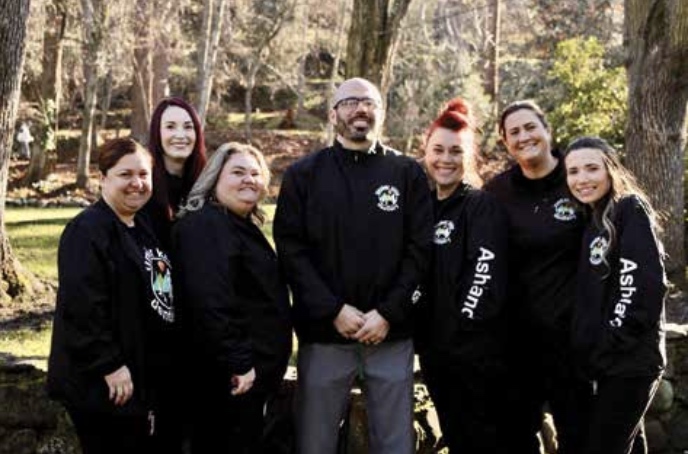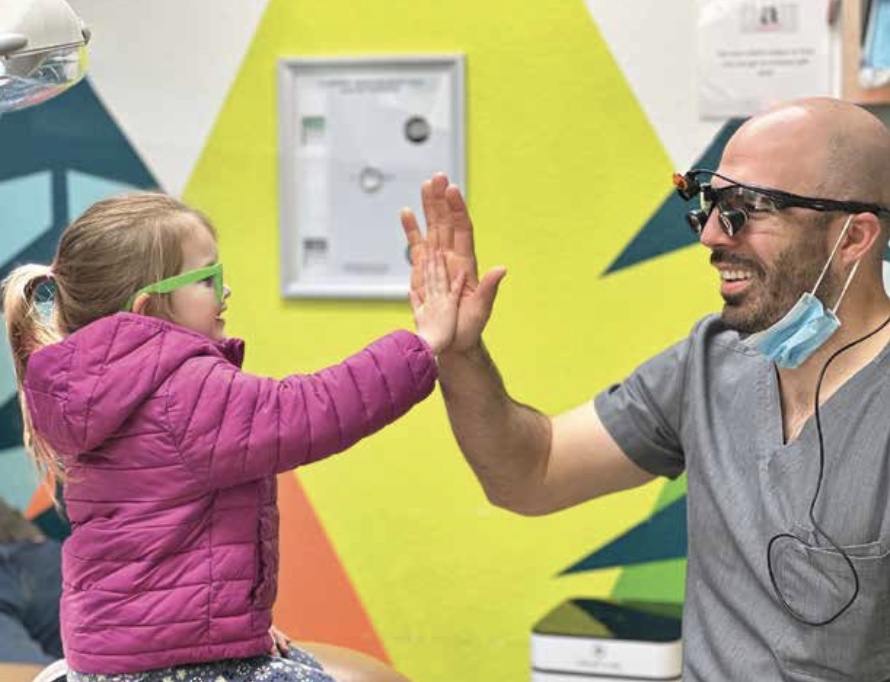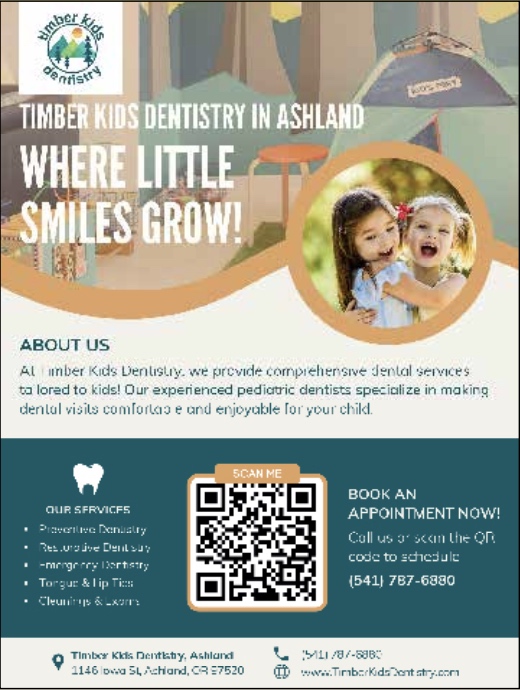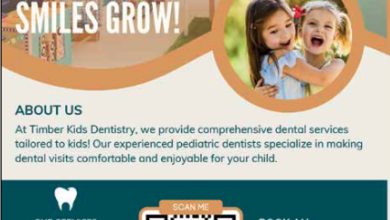Timber Kids Dentistry: Revolutionizing Pediatric Dental
Located in the heart of Ashland, Oregon, Timber Kids Dentistry is redefining pediatric dental care by creating a welcoming and supportive environment for families. Led by Dr. Gonzales, Dr. Bahr, and Dr. Robinson, the practice is dedicated to helping children feel at ease while receiving top-notch dental care. With an emphasis on trust-building, communication, and personalized care, Timber Kids Dentistry ensures that both children and their parents feel comfortable and informed at every step. The team’s mission is to eliminate dental fears, instill confidence, and establish healthy habits that last a lifetime.
Hello Dr. Robinson, Dr. Gonzalez, Dr. Bahr and Carla. Thanks so much for taking the time today to do this interview with us here at the LocalsGuide. To begin with, please introduce us to your practice and tell us about your mission.
Welcome! At Timber Kids Dentistry, we’re more than just a dental office; we’re a team dedicated to creating positive and comfortable dental experiences for children, from infancy through adolescence. Our practice is built around the belief that a healthy smile starts early, and we strive to make every visit fun, educational, and stress-free. Our mission is to build a lifetime of healthy oral habits by providing comprehensive, compassionate, and preventative dental care in a child-friendly environment. We aim to empower our young patients and their families with the knowledge and tools needed to maintain optimal oral health and develop a positive association with dental care, setting them up for a lifetime of bright, confident smiles.
Building trust early is an important part of the work you do. Can you please share how Timber Kids Dentistry helps children overcome dental fears and builds trust during their visits?
At Timber Kids Dentistry, we understand that a child’s first experiences with dental care can significantly shape their future attitudes. Building trust early is paramount, and we approach every interaction with empathy and patience. We’ve created a welcoming and fun environment, designed to feel less like a clinical setting and more like a playful adventure. Our team is extensively trained in pediatric dentistry and communication techniques that resonate with children. We avoid using intimidating terms and instead utilize child-friendly language to explain procedures. Before any treatment begins, we actively involve children in the process, allowing them to explore tools, ask questions, and feel a sense of control. We use a tell-show-do approach, where we explain what we’re going to do, demonstrate it with a toy or our finger, and then proceed gently.
This transparency and gradual approach help demystify the experience, reduce fear, and foster trust.
We also celebrate every small success, reinforcing positive behaviors and building a strong foundation for future dental health. Ultimately, Timber Kids Dentistry aims to make every visit a comfortable and positive one, nurturing a lifetime of confident smiles.
How does your team involve parents in creating a positive dental experience for their children?
Our team understands that a positive dental experience for a child often begins at home. We actively involve parents in several crucial ways to foster a comfortable and even exciting environment for their child’s dental visits. Firstly, we encourage open communication and education. Explaining what to expect to help them prepare for a positive experience with understanding the process for a young child to an older child that has never been or has a dental fear from another office. We often get questions on what the first appointment looks like. During appointments, we take the time to speak directly with parents, explaining procedures, and answering questions, ensuring they’re fully informed and confident. We also provide specific, actionable tips on how parents can reinforce good oral hygiene habits at home, like brushing techniques and dietary recommendations. Furthermore, we recognize that each child is unique and may have different anxieties. We encourage parents to share any concerns or specific needs their child might have, so we can tailor our approach accordingly. By partnering with parents, we create a united front that promotes trust and helps children develop a lifelong positive relationship with dental care.
Collaborating with parents is paramount when addressing children’s dental fears and concerns. A child’s apprehension about dental visits is often fueled by anxieties they may have picked up from their parents or through previous negative experiences. By working closely with parents, we can create a united front, fostering an environment of trust and reassurance. This collaborative approach involves open communication, actively listening to parental concerns, and providing them with the tools and knowledge to support their child at home. Educating parents about the importance of a positive attitude towards dental care and showing them techniques to help their child feel calm and confident before, during, and after appointments, is crucial to breaking the cycle of dental fear.
Moreover, these collaborations offer a valuable opportunity to transform dental visits into positive learning experiences for both parents and children.
By engaging parents in the educational process, we empower them to become active participants in their child’s oral health journey. During these sessions, parents and children can learn together about proper brushing and flossing techniques, the impact of diet on dental health, and other essential aspects of oral hygiene.
This mutual learning not only reinforces healthy habits but also strengthens the parent-child bond through shared responsibility for dental care. By making oral health education a collaborative effort, we can create a home environment that supports and encourages good dental practices, leading to healthier smiles and a lifetime of positive attitudes towards dental care.
Can you explain how the “Tell-Show-Do’ method works and why it’s so effective in easing children’s anxieties?
The “Tell-Show-Do” method is a simple and effective approach that has been widely used in teaching and therapy to help children learn new skills and ease their anxieties. This method involves breaking down the learning process into three clear steps: telling, showing, and doing.
The first step is “telling.” In this stage, the dental assistant explains to the child what they are going to learn. The explanation is clear, concise, and appropriate for the child’s age and level of understanding. The aim is to provide a conceptual framework that will help the child make sense of the concept they are about to learn.
The second step is “showing.” In this stage, the dental assistant demonstrates how it works. They model the behavior or action that the child can see and or hear. This visual demonstration helps the child understand what is expected of them and provides a concrete example of the skill they are trying to acquire.
The final step is “doing.” In this stage, the child gets a chance to practice the new skill or concept with the dental assistant. They are encouraged to try it out and give feedback. The dental assistant provides guidance and support, by helping them build confidence to try something new.
The “Tell-Show-Do” method is effective in easing children’s anxieties because it breaks down the learning process into manageable steps, making it less overwhelming and more approachable for children. Visual demonstration helps children understand what they are expected to do, reducing uncertainty and anxiety. The opportunity to practice and receive feedback helps children build confidence and competence as well as trust to help with reducing anxiety and fostering a sense of accomplishment.
Furthermore, the “Tell-Show-Do” method encourages active learning and engagement, which can help children stay motivated and interested in the learning process. By providing a clear and supportive learning environment, the “Tell-Show-Do” method can help children develop a positive attitude towards learning and build a strong foundation for future learning experiences.
What kind of specialized training have your dentist and dental assistants undergone to work with children and alleviate dental fears?
Working with children requires a special skill set, and dentists who treat pediatric patients often undergo specialized training beyond their general dentistry programs. This training focuses on understanding child psychology, developing effective communication strategies, and mastering techniques to alleviate dental anxiety. Dentists may complete pediatric dentistry residencies, which involve extensive coursework and clinical experience in treating infants, children, and adolescents. These programs emphasize behavior management, sedation techniques, and recognizing developmental dental issues. Dental assistants, similarly, often participate in continuing education courses or on-the-job training that equips them with the tools to create a calming and positive environment for young patients.
They learn techniques for distraction, gentle communication, and how to assist in procedures while minimizing fear and discomfort. Ultimately, this specialized training enables the dental team to provide comprehensive and compassionate care, fostering a positive relationship with young patients and setting the stage for a lifetime of healthy oral hygiene.
How common is dental fear among children, and what are some of the main causes you see?
This is something we see commonly. When bringing the child and their parents to the back together, the child may express they are afraid, they don’t like coming to the dentist. Our assistants will talk to the child why they are afraid or why they don’t like coming to the dentist to help them feel less afraid of being there, by showing them we are there to help them and that it’s fun coming to the dentist.
One major contributor is negative past experiences, such as painful procedures or perceived lack of control during appointments. Hearing frightening stories from peers or family members about dentists can also instill fear in young minds. Furthermore, the clinical environment itself – with its unfamiliar equipment, bright lights, and sometimes sterile smell – can be intimidating for children. Finally, a child’s individual temperament and predisposition to anxiety also play a role, making some children more susceptible to developing dental fear than others.
What are some key recommendations you give to parents to prevent dental trauma, especially in early childhood?
Many adults carry the burden of negative dental experiences from their childhood, which can lead to anxiety and avoidance of dental care later in life. As parents, we have the power to break this cycle and create positive associations with oral health for our children. One key recommendation is to start early and make it fun. Begin cleaning your baby’s gums even before teeth emerge, introducing them early to the feeling of having something in their mouth. When teeth do erupt, use soft brushes and make brushing a fun activity, perhaps with songs or games. Another crucial aspect is choosing the right dental professionals. Seek out pediatric dentists who are experienced and comfortable working with children. A dentist’s demeanor and environment can greatly impact a child’s comfort and trust. Additionally, avoid sharing your own dental fears or negative experiences with your child. Instead, frame dental visits as a routine health check, emphasizing the importance of strong, healthy teeth. Finally, be prepared for the visit. Talk about the appointment beforehand in a positive and age-appropriate way, avoiding terms like “pain” or “needle.” By focusing on these strategies, parents can significantly reduce the likelihood of their children developing dental trauma and instead, foster a lifelong commitment to good oral health.
Can you please share some recent testimonials and success stories with us?
Here are some of our 5-star Google reviews we have received about our office and team here in Ashland:
“Timber Kids in Ashland is the absolute best! They are kind, friendly and so patient especially when it comes to one of my little ones that has a bit of dentist anxiety. Highly recommend!”
– Stacy B.
“As always, the staff here was very accommodating, caring, gentle, and friendly. The kids actually look forward to going to the dentist!”
– Betsy P.
“We love this dentist, they’re amazing at calming anxious kiddos and the whole office is pleasant and kind.”
– Emily P.
Our team loves it when our kids’ parents tell us their child did so much better here compared to what they have seen and experienced from another office before finding us.
Our team was able to get their child to allow us to brush their teeth and lay down on the bench, but was able to take X-rays as that was not something their child was not able to accomplish at another office.
Why are baby teeth so important, and how does the care approach differ from that of adult teeth?
Baby teeth, also known as primary teeth, are far more crucial than their temporary nature might suggest. They serve as placeholders for the permanent adult teeth, guiding them into the correct positions and ensuring proper alignment of the jaw. Beyond their role in creating space, baby teeth are vital for chewing and proper nutrition, facilitating the development of speech, and contributing to a child’s self-esteem and confident smile. Losing baby teeth too early due to decay or injury can lead to misalignment and crowding of adult teeth, often requiring orthodontic intervention later in life. Therefore, the importance of maintaining healthy primary teeth throughout childhood cannot be overstated.
The care approach for baby teeth differs from that of adult teeth in a few key areas. Firstly, early establishment of good oral hygiene habits is paramount. While adults might focus on brushing twice daily, the emphasis with children is on parental assistance with brushing and flossing until they develop the dexterity and understanding to do it effectively on their own. Fluoride is a critical component of both care strategies, but children might require smaller doses or specialized pediatric fluoride toothpaste. Furthermore, dietary management is often more pertinent with children, limiting sugary drinks and snacks that quickly contribute to decay. Finally, regular pediatric dental check-ups, including professional cleanings and fluoride treatments, are essential starting in infancy to monitor tooth development, detect early signs of decay, and educate both child and parent on proper oral hygiene practices. While the ultimate goal for both primary and adult teeth is preservation and prevention of disease, the specific strategies and intensities differ to accommodate the unique needs of a developing mouth.
How do the words parents use influence their child’s perception of visiting the dentist?
The language parents employ when discussing dental visits can profoundly shape a child’s perception of the experience, often setting the stage for either calm acceptance or anxious dread. Using words like “shots” or “drills” can inadvertently instill fear, conjuring up images of pain and discomfort that fuel anxiety. Instead, framing the visit with positive, age-appropriate language can make a significant difference. Describing the dentist as a “tooth helper” or the examination as “counting and cleaning” can transform a potentially frightening event into a more manageable and even exciting adventure. Emphasizing the importance of healthy teeth and celebrating the positive outcomes of a dental visit, such as a bright smile, reinforces the idea that the dentist is an ally in maintaining well-being, not a source of trepidation. Consequently, the careful selection of words can help children approach dental appointments with curiosity and confidence, rather than apprehension. We review with our parents if they are not sure how to go over what we need to do. I tell our parents to let us talk to your child when they come back for the next appointment, as we have ways of not using what we call “scary words,” and also to ensure we are not doing something you promised wouldn’t be done. For instance, if they ask you, “are they going to give me a shot?” If they are younger and you say “yes,” that will make them NOT want to come in as they associate a shot as painful. We like to look at it as we are giving the tooth some sleepy juice to help the tooth fall asleep. The child is more willing to allow us to put the tooth to sleep as they know going to sleep, they don’t associate that as being painful like a shot would feel.
Can you tell us about the concept of “Happy Visits” and how they help set a positive tone for future appointments?
Absolutely, I’d be happy to explain the concept of “Happy Visits” and how they can contribute to a positive experience for children. “Happy Visits” are a type of preventive dental appointment specifically designed for young children, usually aged 1-3 years old. The main goal of these visits is to help children become familiar with the dental office environment, the dental team, and the various sights, sounds, and sensations associated with dental care. By doing so, “Happy Visits” can help children develop a positive association with dental visits and reduce the likelihood of dental anxiety or fear in the future.
During a “Happy Visit,” the child is introduced to the dental team and the dental office in a friendly and non-threatening manner. The child may be given the opportunity to sit on the dental chair, if the child shows interest in sitting on the chair or laying down we may try to count the child’s teeth using a small mirror, and demonstrate the Tell-Show-Do method on how the dental tools work in a safe and playful way. The dental team may also provide age-appropriate guidance on oral hygiene practices and nutrition to promote good oral health habits from a young age.
By taking a proactive approach to children’s dental care, “Happy Visits” can help set a positive tone for future dental appointments. Children who have positive experiences at the dentist are more likely to maintain good oral health habits and seek regular dental care as they grow older. This can lead to better overall oral health, improved self-confidence, and a higher quality of life.
In summary, “Happy Visits” are an important concept in pediatric dentistry that can help children develop a positive association with dental care. These visits provide an opportunity for children to become familiar with the dental office environment, the dental team, and the tools and procedures used in dental care. By promoting a positive dental experience, “Happy Visits” can help set the stage for a lifetime of good oral health habits and regular dental care. They also get to pick out a toy when they are done.
What would you say to a parent who is hesitant to bring their children to the dentist, and how can they get started with Timber Kids Dentistry?
It’s completely understandable to feel hesitant about bringing your child to the dentist, especially if you’ve had less-than-positive experiences yourself or if your child expresses fear. We recognize that a child’s first dental experience can shape their perception of oral care for years to come. However, establishing good dental habits early is crucial for their overall health and well-being, preventing potential problems down the line. Think of it as building a foundation for a lifetime of healthy smiles.
Delaying dental visits can allow minor issues to become more serious and require more complex treatment later on, potentially causing even more anxiety for your child. The good news is that modern pediatric dentistry is focused on creating a comfortable and positive environment, specifically designed with children in mind.
If you’re considering Timber Kids Dentistry, we understand that taking that first step can feel a little daunting. Getting started is actually quite simple! We encourage you to visit our website or give us a call to learn more about our practice philosophy, the team, and what a typical first visit looks like. We’re happy to answer any questions you may have – no question is too small. We also have resources and photos of our office that can help familiarize you and your child with the environment before the actual visit. You can also request a complimentary tour of our office and comfortable treatment rooms beforehand, which can significantly reduce any anxiety your child may have. Starting with a simple “Happy Visit” appointment can also be a wonderful way to introduce your child to the team and the environment in a non-threatening way, without any procedures involved. We believe in building a positive and trusting relationship with both parents and children, making dental visits something to look forward to rather than fear.
Finally, how can we go ahead and set up an appointment with you?
We’re excited about the possibility of working with your family to ensure we can dedicate the necessary time and attention to your child’s needs, and to get the ball rolling, setting up an appointment is the next step. We want this process to be as smooth and easy as possible. You can choose the scheduling method that suits you best; we have an online booking system available on our website, www.timberkidsdentistry.com, you can simply give us a call at (541) 787-6880 or scan the QR code. We’re flexible, and we’ll collaborate to find a time that perfectly fits your schedule. Let’s connect and see how we can help!
Learn More:
Timber Kids Dentistry
1146 Iowa St, Ashland
(541) 787-6880




